A roomful of anxious toys face the dangers of domestic dust in ‘Something’s Lurking’, a Psyop spot for LG’s Kompressor Elite vacuum cleaner. We spoke to lead 2D artist Nick Tanner to get an in-depth look at how the spot came together.
Psyop’s brief, through agency Young & Rubicam NY and production company Smuggler, was to present the menace lurking in everyday floors and rugs. This was ultimately represented by ‘dust’ shark fins threatening several toys, each depicted in daring and dramatic still poses. The LG vacuum cleaner eventually saves the day and removes the fins, and dust, from existence. “The directors here at Psyop were keen to do a toy spot unlike any that were doing the rounds,” says lead 2D artist Nick Tanner. “They came up with the idea of trying to mix and match some movement in the otherwise static scenes to create these dynamic tableau. The idea was then to reflect a pastiche of dramatic films, Jaws being an obvious one. A lot of the vignettes were supposed to be reminiscent of feature films but on a smaller scale.”
Production
Psyop began production on ‘Something’s Lurking’ by previs’ing while the set was being built, with the help of production designer Clem Price-Thomas’ concepts and storyboards. “He designed the set in tandem with our previs,” says Tanner. “It was an incredible useful thing to be able to do because it meant on day one we had a pretty accurate model of everything that we shot, which was quite luxurious, really. It also meant we could be pretty tight about the actual shooting. I think we shot it all in one day.”
An open-wall lounge room set was built on a raised platform, featuring large windows overlooking a city skyline. Director of photography Fred Elmes shot with an Arri ALEXA mounted on a Technocrane, fitted with a periscope lens for about 90 per cent of the shots. “It’s actually a pretty old lens arrangement,” says Tanner. “But that’s how we got to the floor, which was another thing we were very keen on from the beginning. We really wanted to be on a toy’s eye view and low to the surface. We were looking at all the shark movies – Jaws and Deep Blue Sea – and we realised it was critical that you had to be there at the water level for the sense of the threat to be present.”
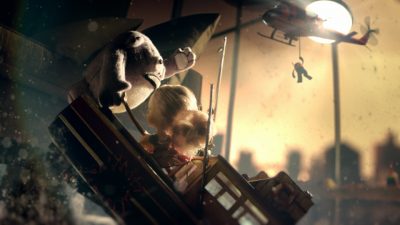 The periscope lens presented some severe, but interesting, lens and chromatic distortion for Psyop. “We left the lens distortion in because we liked the character of it,” notes Tanner. “It’s something that people don’t see too much of these days and it has some slightly unnerving and odd optical qualities, which fit in with the nature of the piece.” To handle the chromatic distortion, Tanner reviewed some test patterns filmed at the beginning of the shoot day and created a set-up in Nuke that would manipulate the scales on the RGB channels – all within a couple of hours and while the shoot was continuing.
The periscope lens presented some severe, but interesting, lens and chromatic distortion for Psyop. “We left the lens distortion in because we liked the character of it,” notes Tanner. “It’s something that people don’t see too much of these days and it has some slightly unnerving and odd optical qualities, which fit in with the nature of the piece.” To handle the chromatic distortion, Tanner reviewed some test patterns filmed at the beginning of the shoot day and created a set-up in Nuke that would manipulate the scales on the RGB channels – all within a couple of hours and while the shoot was continuing.
Rather than opting for greenscreen outside the windows, a skyline translight was instead incorporated into the set. This was filmed without glass – the reflections were constructed in post out of still frames projected onto cards or pieces of geometry. Says Tanner: “I was worried that we weren’t going to have time to do really good skies and city scene replacements. Because the window dominates so much of the room, and we’ve got these metallic objects that were very reflective, I just thought if we could get a decent translight we could circumvent a lot of time consuming tasks in post. It also gives the DP the chance to really incorporate the external light sources as part of his lighting set-up. He’s not second-guessing what the exterior of the window has to look like.”
Although the skies were augmented in terms of adding more depth of field, putting them out of focus and adding in some atmosphere, the translight gave, according to Tanner, “a real sense of the shape of the spot without having to fill in these big green holes which is so often the case. We also got rid of the sheer amount of time it takes to paint up these cityscapes. It’s great for this spot where so much of the lighting comes from that exterior source.”
Fred Elmes lit the spot in warm tones, which became a strong look for Psyop to match to. “We did some work with Fred on set in Nuke just to adjust and augment what we were getting from the Arri ALEXA,” says Tanner. “He also created a look-up table with his assistant there that lined things up to how he was imagining it was going. I think it’s really nice to start working with something that already has a strong look to it, rather than working in a flat environment and force that look in later on. On a compressed schedule, it means that everyone is looking at something they like from the word go and the clients or agency is not having to wait around to see something that looks exciting.”
Psyop played with the lighting significantly in post, pulling apart the live action plates to add some light sources, volumetrics and depth of field in almost every shot. “We just shrank that depth of field down slightly,” says Tanner. “So although we’re on a pretty wide lens, we just try and push it to a slightly long lens feel. Again, it’s a slightly unusual feeling and perhaps technically wrong, but gives it some personality.”
Toy enhancement
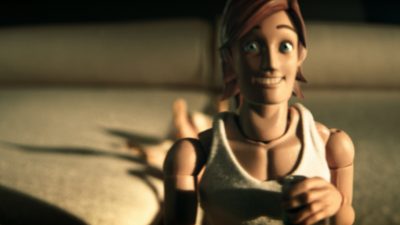 The toys, which included male and female dolls, bears, a boat, green army men and many others, were a mix between purchased models and ones made from scratch. “We augmented and twisted a lot of the toys to make them either unrecognisable or more suited to the world we were presenting,” notes Tanner. “So, for the teddy bear who drowns or his mother who looks on from the shore, they were actually original toys, but we removed their mouths or eyes and replaced them upside down to replace their emotional qualities. A lot of that was done practically, and then we did the same thing in post as well when that wasn’t achievable practically, or we needed to do an animated gag.”
The toys, which included male and female dolls, bears, a boat, green army men and many others, were a mix between purchased models and ones made from scratch. “We augmented and twisted a lot of the toys to make them either unrecognisable or more suited to the world we were presenting,” notes Tanner. “So, for the teddy bear who drowns or his mother who looks on from the shore, they were actually original toys, but we removed their mouths or eyes and replaced them upside down to replace their emotional qualities. A lot of that was done practically, and then we did the same thing in post as well when that wasn’t achievable practically, or we needed to do an animated gag.”
“The little wooden guy in the boat at the beginning is our kind of Roy Scheider reference,” continues Tanner. “He was built out of wood and we made two heads for him with two different expressions drawn on by our designers. Later on you get the Titanic couple, where we didn’t have enough time to manufacture two heads and different expressions. Although it’s a fairly subtle effect across the cut, the boy’s face changes and the girl’s eyeline changes. They were 2D tweaks done in post just by lifting elements out of the plate and re-arranging and tracking them back in.”
Such 2D tweaks became crucial for Psyop to be able to mix and match the types of effects in the spot. “We always wanted to do a mix of effects here so you’re never really sure how we did it,” notes Tanner. “We thought that was going to create an eternally consistent world of nothing being quite real, although it’s quite realistic. So we had this idea we would use as many different techniques as we could, even though they’re achieving a similar effect. There’s even one shot where there’s a little purple guy beneath the table and his eyes actually change during the shot as a shark fin goes past him. That was obviously a nod we could only do in post, just to give a slightly surreal edge to what’s going on. I think you’re never really meant to be entirely sure what’s happening.”
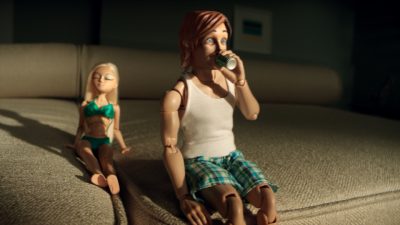 The male and female dolls seen reclining on the couch were realised with full CG head replacements rendered in mental ray, so that the characters could convey different emotional and dramatic expressions, and even something further. “There’s actually a director’s cut that has a little more sense of sauciness between these guys,” says Tanner, “but that didn’t make it in sadly.”
The male and female dolls seen reclining on the couch were realised with full CG head replacements rendered in mental ray, so that the characters could convey different emotional and dramatic expressions, and even something further. “There’s actually a director’s cut that has a little more sense of sauciness between these guys,” says Tanner, “but that didn’t make it in sadly.”
Other enhancements included taking a bite out of the plastic duck’s head, adding a screaming mouth to one of the toys and extending the boat in the helicopter scene. “They started making the waves go so high and so low that the boat ended up being below the surface of the floor,” says Tanner. “Originally we just sliced off the bottom of the bottom of the boat. So we had a fun time of extending the boat and make it look like it wasn’t moving while the floor was moving.”
Shark fins and the moving carpet, in CG
Many of the toy expressions in the spot match the impending threats presented by the shark fins and the carpet which begins to move like massive waves, effects that were created using computer graphics under lead 3D artist Christian Bach. The fins were realised as a particle system and rendered using the mental ray rasterizer. Secondary particles coming from the fins were created done by Jimmy Gass and ambient dust in the air was produced by Miguel Salek.
Some wooden and furry shark fins were pushed through the scene on set for reference. “Texturally they didn’t really reflect very accurately what we ended up with,” says Tanner. “They were quite crude but you got some good cues, such as shadow density. Actually, when the fin cuts across the boat, behind the Roy Schneider character, and the shadow that falls on the sail – well, I’m not sure without reference whether we would have realised to do that. We saw it in our reference plate and it’s like, oh yeah of course. It’s nice to get those visual cues from in-camera.”
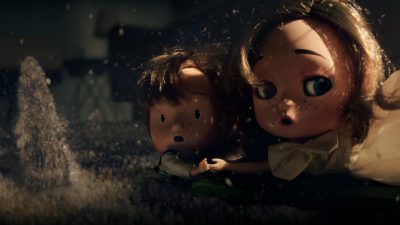 As the shark fins become more and more threatening, the carpet begins to undulate and eventually forms much larger ‘waves’. “The post process was an evolving thing right up until the very end,” says Tanner. “So the carpet wasn’t initially going to move that much – it was going to be just a suggestion of movement that it might be water. They then became much larger turbulent waves. We didn’t really shoot for that, it evolved quite late.”
As the shark fins become more and more threatening, the carpet begins to undulate and eventually forms much larger ‘waves’. “The post process was an evolving thing right up until the very end,” says Tanner. “So the carpet wasn’t initially going to move that much – it was going to be just a suggestion of movement that it might be water. They then became much larger turbulent waves. We didn’t really shoot for that, it evolved quite late.”
The rug waves were created initially by projecting the footage back onto a particle simulation driven by the animation of the shark fins, a set-up by David Barosin. When the carpet waves become more like real waves, artists created a particle simulation in which all the carpet fibres were modeled as objects and behaved according to certain forces. 3D artist Jonah Friedman was responsible for lighting and rendering the particles through Arnold. “Jonah was there on set capturing his HDRs and then taking it into Arnold, which is particularly good at simulating radiosity,” says Tanner. “He would adapt his HDR set-ups and then start doing more precise lighting with his own light sources based on the HDRs and talking with the DP on the day.”
“The carpet was rendered in Arnold with Melena strands which were really fantastic for this project,” says Friedman. “Arnold was very powerful in that we could render the hundreds of thousands of carpet strands in the spot for real. In Arnold you can render strands as ribbons like you can in mental ray, or you can render them thick. The carpets were entirely made as thick strands. The Melena framework is really open-ended in ICE.”
An earlier shot in ‘Something’s Lurking’ features a low camera move over the wooden floor that then sweeps through the carpet fibres of a rug and out again, in a shot that combined all of the particles, rendering and compositing approaches by Psyop used in the spot. Ultimately, the ‘through the rug shot’ blended a CG floor and rug with a live action plate. “We shot as close to the ground as we could,” says Tanner, “but we knew we couldn’t get close enough to get into this carpet. So we projected the scene back onto matching geometry and added the CG camera that off-set us to go further down into the ground than we could achieve on shoot day.”
The rug’s fibres were particles created by 3D artist Todd Akita. “Then the interior of the rug is a combination of Arnold renders plus a lot of textures generated from noise patterns painted in Nuke to create this dirty atmosphere,” says Tanner. “There were a bunch of particles re-appropriated from other scenes. I just built little flickering scenes from still frames of particles, and then there were also dedicated particles generated for this scene.”
For the shot emerging from the rug, Tanner had to stabilise the live-action periscope lens move and re-build the depth of field to match the association with the dolls sitting on the couch. “The join in the carpet in this shot is across several shadows falling across the carpet,” says Tanner. “Those shadows are lined so perfectly because the 3D guys were able to be on set and had a great understanding for the space they were trying to re-create. That was the strongest, most interesting, most useful thing that we did – to have the key players on set, which we don’t get to do all that often because it’s not always practical and because they’re often too busy working on other projects.”
Lighting
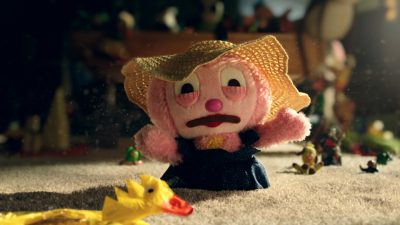 The spot’s strong lighting necessitated close interaction between the 3D and 2D artists. On set, Jonah Friedman took HDR plates and gave them a neutral white balance to line them all up with each other. They were then passed down to Nick Tanner, who created a colour correct in Nuke to match the HDR frames to the warm look of the plates. “Jonah then took that Nuke colour correct set up and converted it into a look-up table,” says Tanner, “which he was then working with when he was doing his lighting.”
The spot’s strong lighting necessitated close interaction between the 3D and 2D artists. On set, Jonah Friedman took HDR plates and gave them a neutral white balance to line them all up with each other. They were then passed down to Nick Tanner, who created a colour correct in Nuke to match the HDR frames to the warm look of the plates. “Jonah then took that Nuke colour correct set up and converted it into a look-up table,” says Tanner, “which he was then working with when he was doing his lighting.”
“He would then fire back un-colour corrected renders to me,” adds Tanner, “and I could just apply variance to the set up I’d given to him on day one to make his stuff match into the scene. That meant he was looking at something that was semi-comped while he was lighting it. Meanwhile, I was getting stuff from him that was incredibly predictable. So I already had existing colour correct set ups that would get me to 90 per cent of the comp just be adding the passes together and using the look-up table back at my end.”
Compositing
To integrate the CG elements and other augmentations into the scenes, Psyop developed a pipeline for tracking and lens disortion, led by Joerg Liebold. “We took our model of the room that we’d built for the previs, which the actual set was based on,” says Tanner. “We got Joerg to track all the cameras and put every shot inside the one room, so at any point we could reference each camera to one another and make sure the objects were all consistently lined up. So for any setup we had one model that let us pull out any camera we needed from it. All our scales were consistent and that made going from shot to shot consistent, say where you needed to line up a depth map.”
For the lens distortion, Liebold came up with a series of reference images and calculated distortion in 3D using 3D tracks. “He then supplied me with the reference images which I plugged into Nuke,” says Tanner. “We then established an oversized plate which 3D would render out, allowing me to add the distortion into the undistorted 3D renders. That meant we could maintain the lens distortion signature, which was quite extreme in the live action and the CG.”
Tanner then relied on the 3D capabilities of Nuke to create depth of field. “I would take 3D geometry or build rough pieces of geometry out of cards to create depth maps to augment the depth of field,” says Tanner. “It came into a lot of use when we were manipulating the translight in the background, adding in atmosphere and distortion sources. In some shots there’s a flicker in the lights, and that was just based on noise patterns being positioned in front of the translight and doing distortions based on colour corrections. The biggest thing about using the 3D in Nuke was creating cheating depth maps that made for a nicer fake depth of field.”
For Tanner, ‘Something’s Lurking’ was his first full project compositing in Nuke. One particularly useful aspect of the software he found was the ability for more interaction between the 2D and 3D artists. “We had some real problems with motion vectors, for example,” says Tanner. “It turned out they were rendered incorrectly, but rather than re-rendering the vectors, we just created our own Nuke script to let me use them properly. Which means the 3D guys are getting a better understanding and are getting more involved in compositing.”
“Also, it just feels like you’ve got direct control of the pixels in Nuke and you’re not jumping through hoops, and you’re not letting plugins or presets get in the way of what you’re trying to achieve creatively. Working in linear light is also a real eye opener – it really changes your approach to compositing, especially on the photoreal side of things where it can achieve so much with that extra gamut you have to play with. It was also consistent between nodes – the colour correct values are the same between them. The reconciled 3D in particular is such a fantastic tool. Also, the fact that I can run it on a laptop is great. There’s just almost no down time on a set any more – you can start colour correcting and adding fine detail to what you’re working on.”
The final shot
When LG’s Kompressor Elite vacuum cleaner finally makes an appearance, the shark fins are drawn into the machine, disintegrating into a dust particles. “Normally, we do these things so often with wipes and cheats to let things disintegrate or wipe off, whereas here it’s actually the model of the fin breaking apart into particles done in ICE,” says Tanner. “In the end, the whole sequence was then built in compositing in about two hours with just one revision.”
Although this final shot was heavy on visual effects, most of the spot maintained a high level of augmented reality. “There’s something quite nice about having it all real, but making it slightly unreal,” notes Tanner. “It’s kind of a reverse of what we’re doing most of the time which is starting with something unreal and desperately trying to make it real. Here we really started with an image that was 90 per cent real and just pushed it slightly into this unreal world.”
Credit List
Agency: Young & Rubicam NY
Executive Creative Director: Scott Vitrone
Executive Creative Director: Ian Reichenthal
Global Creative Director: Stuart Harricks
Global Creative Director: Andrew McKechnie
VP, Creative Director / Art Director: Gabriel Hoskins
Creative Director / Writer: Cheryl Chapman
Executive Director of Content Production: Lora Schulson
Executive Director of Content Production: Nathy Aviram
Senior Content Producer: Tennille Teague
Executive Music Producer: Eric David Johnson
Assistant Content Producer: Luiza Naritomi
Production Company: Psyop / Smuggler
Director: Psyop
Psyop Creative Directors: Marie Hyon, Marco Spier
Executive Producers (Psyop): Lucia Grillo, Justin Booth-Clibborn, Lydia Holness
Producers (Psyop): Michael Neithardt, Sean Sullivan
Executive Producer/Partner (Smuggler): Patrick Milling Smith
Executive Producer/Partner (Smuggler): Brian Carmody
Executive Producer/COO (Smuggler): Lisa Rich
Executive Producer (Smuggler): Allison Kunzman
Head of Production (Smuggler): Laura Thoel
Live Action Producer (Smuggler): Erin Wile
Director of Photography: Fred Elmes
Animation: Psyop
Lead 3D Artist: Christian Bach
3D Artists: Todd Akita , Alvin Bae, Jonah Friedman, David Barosin, Miguel Salek, Xuan Siefert, Jimmy Gass, Pat Porter, Kitty Lin, Keith Kim
3D Animator: Jae Ham
Lead 2D Artist: Nick Tanner
2D Artists: Adam Flynn, Dan Short
Designers: Anh Vu, Jonathan Saunders
Editor: Cass Vanini
Storyboard Artist: Ben Chan
Tracking: Joerg Liebold
Design Interns: Sam Ballardini, Hung Liao
Music and Sound Design: Q Department

Beautiful work. Would love to know the timeline for the project.
Pingback: LG Kompressor Elite Commercial | Scene 27